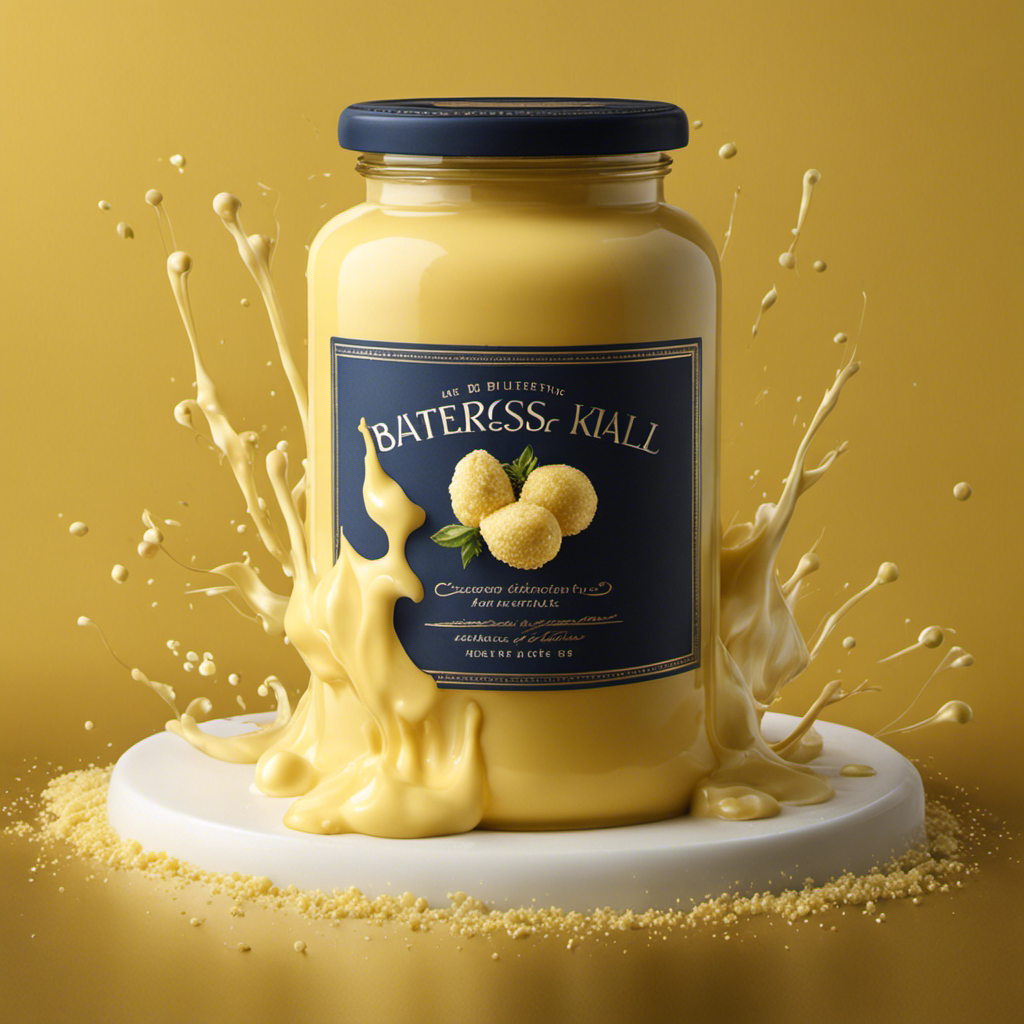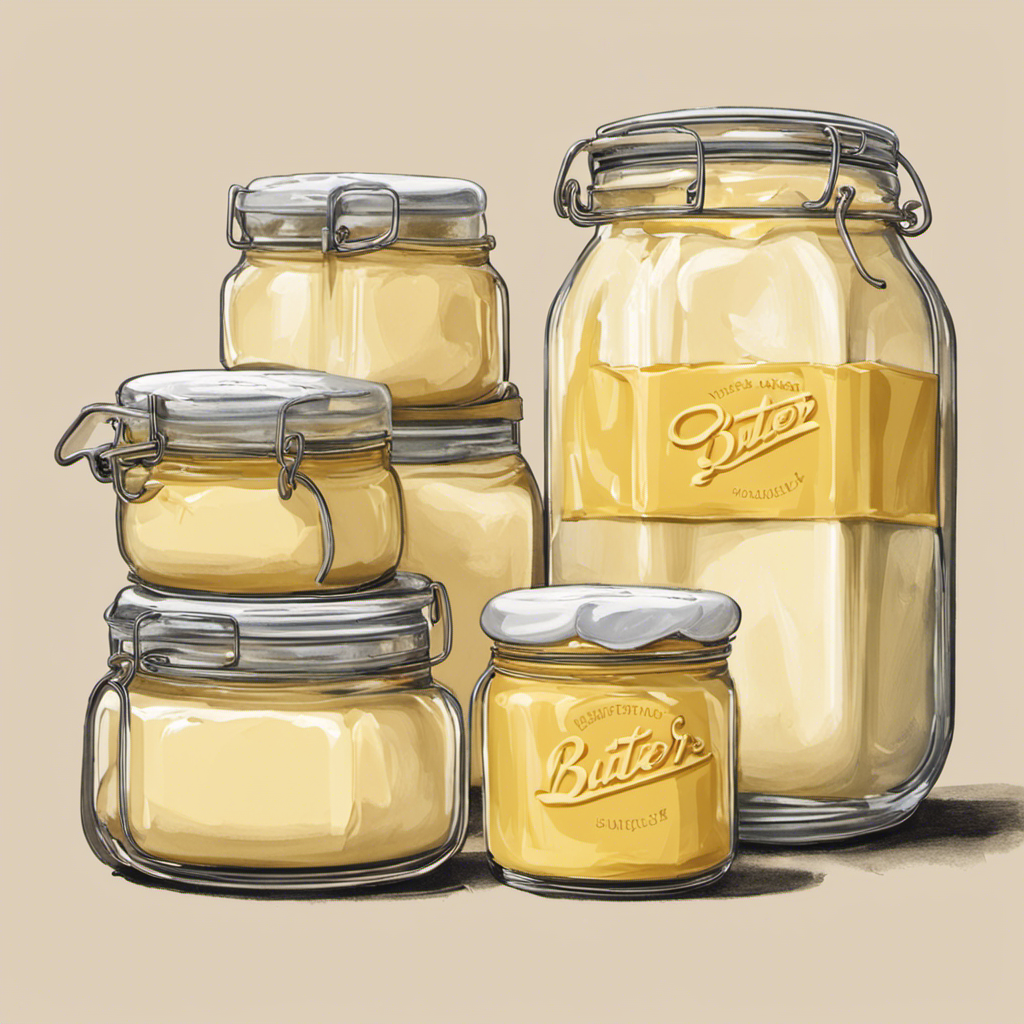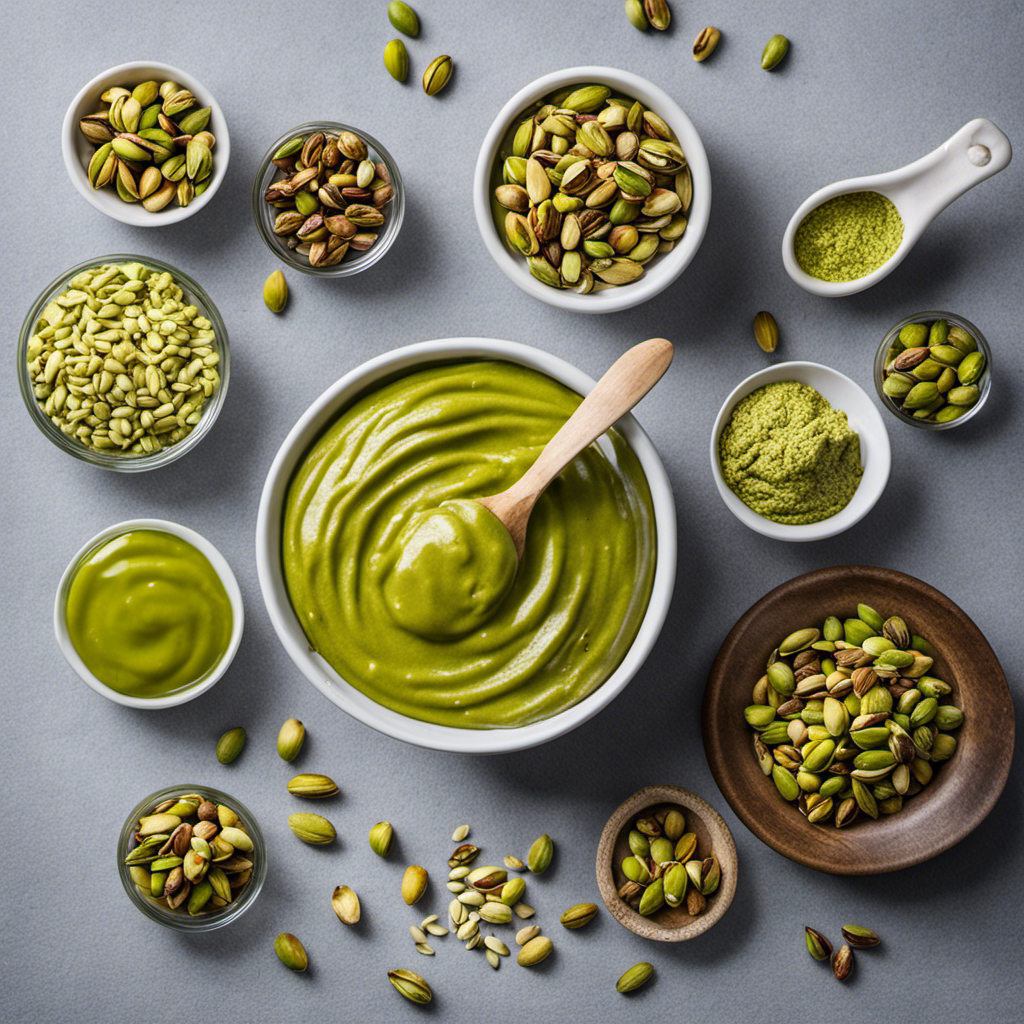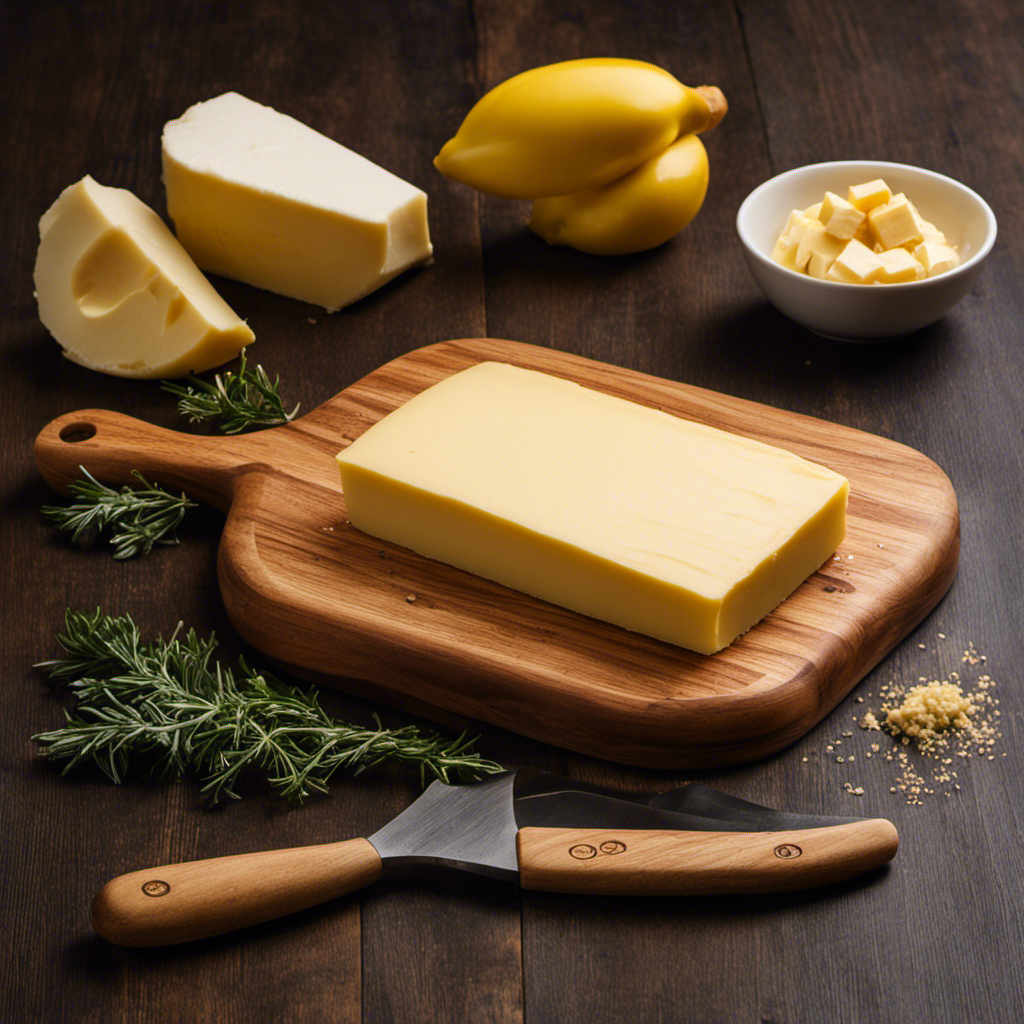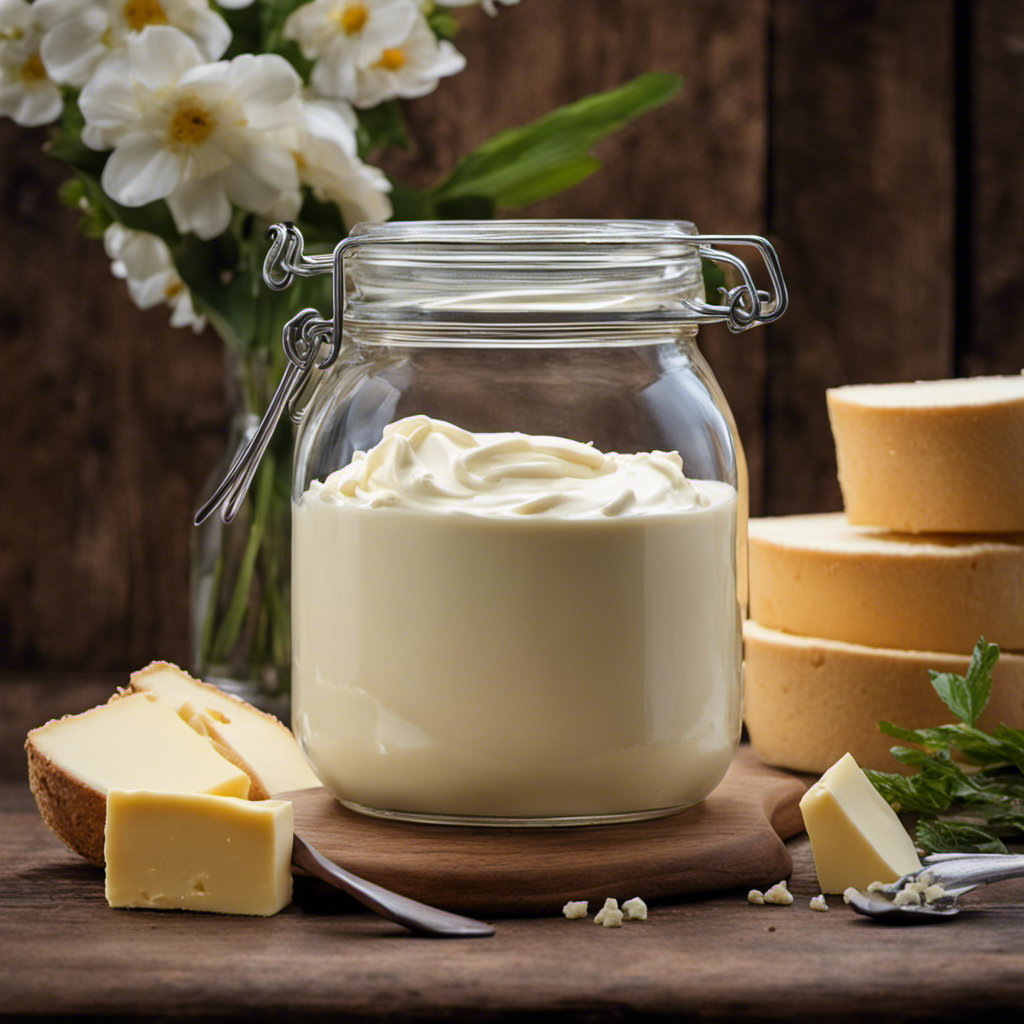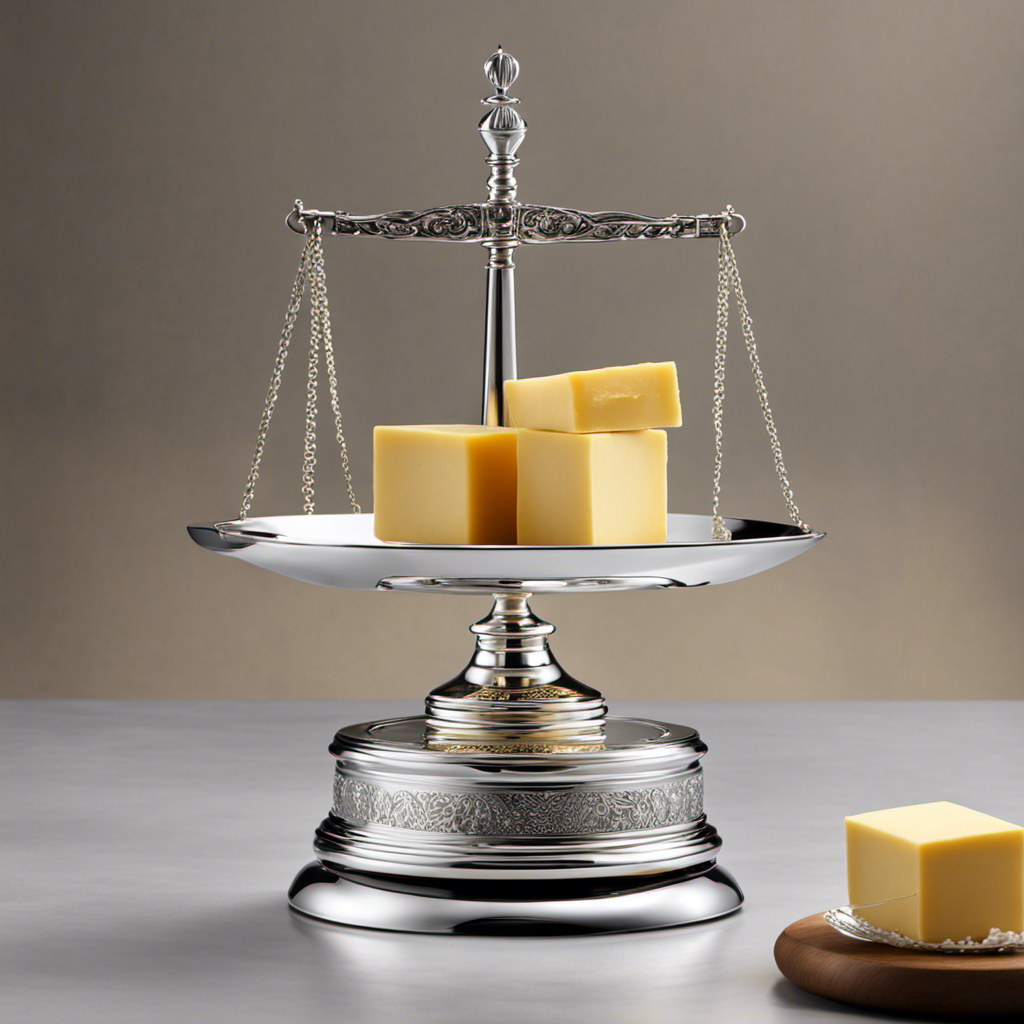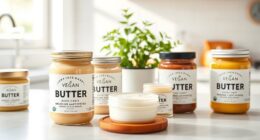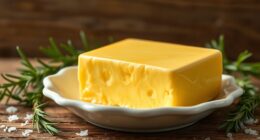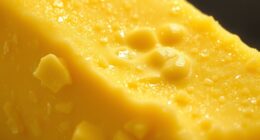One often hears that the most wonderful things in life are those made at home, and this is especially evident when it comes to butter.
In this article, I’ll show you how to make butter in a jar using simple ingredients and tools.
With a little bit of churning and straining, you’ll have a creamy, delicious spread that will elevate any meal.
So, roll up your sleeves and get ready to embark on a butter-making adventure that will leave your taste buds begging for more.
Let’s dive in!
Key Takeaways
- Choose high-fat heavy cream without additives or preservatives
- Sterilize the jar to eliminate bacteria and contaminants
- Gather necessary tools and equipment for the butter-making process
- Experiment with flavor variations and proper storage techniques for homemade butter
Choosing the Right Ingredients
Before you begin, make sure you have the right ingredients for making butter in a jar. Choosing the right ingredients is crucial to achieving the perfect taste and texture.
For homemade butter, it’s best to use heavy cream that has a high fat content. Look for cream that is fresh and free from any additives or preservatives. Organic, grass-fed cream is also a great option if you prefer a more natural flavor.
Additionally, consider your taste preferences when selecting the ingredients. If you like salted butter, you can add a pinch of salt to the cream before shaking it.
Now that you have the right ingredients, let’s move on to preparing the jar and tools for making butter.
Preparing the Jar and Tools
When it comes to preparing the jar and tools for making butter, there are several key points to consider.
First, it is important to sterilize the jar to ensure that it is free from any bacteria or contaminants that could affect the quality and safety of the butter. This can be done by washing the jar in hot, soapy water and then boiling it in a pot of water for a few minutes.
Additionally, it is necessary to gather the necessary tools and equipment, such as a butter churn or a jar with a tight-fitting lid, a thermometer, and a clean cloth or cheesecloth for straining the butter.
Lastly, it is crucial to take safety precautions into account, such as wearing gloves to protect your hands from hot surfaces and using caution when working with boiling water.
Jar Sterilization Techniques
To ensure cleanliness, it’s important to sterilize the jar before making butter. Proper sterilization ensures that harmful bacteria and contaminants are eliminated, reducing the risk of spoilage and ensuring the butter remains safe to consume. There are several methods for sterilizing a jar, each with its own advantages and limitations:
-
Boiling: Placing the jar in boiling water for a few minutes effectively kills bacteria and other microorganisms.
-
Bleaching: Soaking the jar in a solution of bleach and water, then rinsing thoroughly, is another effective method.
-
Steam sterilization: Using a pressure cooker or steam sterilizer, the jar is exposed to high heat and pressure, effectively sterilizing it.
-
Oven sterilization: Placing the jar in an oven preheated to a specific temperature kills bacteria and sterilizes the jar.
-
Chemical sterilization: Using chemical sterilizing agents like hydrogen peroxide or food-grade sanitizers effectively sterilizes the jar.
Necessary Tools and Equipment
You’ll need a few necessary tools and equipment for the process.
First and foremost, choosing the right jar is crucial. Opt for a glass jar with a tight-fitting lid to ensure proper sealing and storage of your homemade butter. It should be of adequate size to accommodate the cream and allow room for shaking.
Additionally, cleanliness plays a vital role in butter-making. Make sure all your tools and equipment are thoroughly cleaned and sanitized to prevent any contamination. Sterilize the jar by boiling it in water for a few minutes or running it through the dishwasher on a hot setting.
Maintaining a clean environment throughout the process will help ensure the quality and safety of your homemade butter.
Safety Precautions to Consider
Ensure that all tools and equipment are cleaned and sanitized to maintain a safe environment throughout the butter-making process. When it comes to food handling, cleanliness precautions are of utmost importance. Here are some key precautions to consider:
- Wash your hands thoroughly before and after handling any ingredients or equipment.
- Clean all surfaces and utensils used in the butter-making process to prevent cross-contamination.
- Use separate cutting boards and knives for raw ingredients such as herbs and spices.
- Store ingredients properly to avoid spoilage and contamination.
- Regularly inspect and clean your storage areas to prevent the growth of harmful bacteria.
By following these cleanliness precautions, you can ensure that your butter-making process remains safe and hygienic.
Churning the Cream
Start shaking the jar vigorously to churn the cream into butter. Churning cream is an essential step in the butter-making process. The type of cream used and the method of churning can greatly affect the outcome of the butter.
There are two main types of cream commonly used for making butter: heavy cream and whipping cream. Heavy cream contains a higher fat content, typically around 36-40%, which makes it ideal for butter-making. Whipping cream, on the other hand, has a lower fat content, usually around 30%, and may result in a softer, less dense butter.
When it comes to churning methods, there are various techniques you can employ. These include using a jar, a stand mixer, a food processor, or even a traditional churn. Each method has its advantages and disadvantages, so it’s important to choose the one that suits your preferences and equipment availability.
Experimenting with different cream types and churning methods can yield unique and delicious results in your homemade butter.
Straining the Buttermilk
To strain the buttermilk from the freshly churned butter, pour the mixture into a fine mesh sieve or cheesecloth-lined colander. This step is crucial in separating the liquid buttermilk from the solid butter.
Here are some key techniques and uses for straining buttermilk:
-
Cream separation: Straining helps separate the cream from the buttermilk, resulting in a creamy, rich butter.
-
Flavor enhancement: By removing the buttermilk, you can customize the flavor of your butter by adding herbs, spices, or even honey.
-
Baking ingredient: Buttermilk is a versatile ingredient in baking, adding moisture and tanginess to cakes, biscuits, and pancakes.
-
Culinary applications: Strained buttermilk can be used as a marinade for tenderizing meat or as a base for salad dressings and sauces.
-
Culturing: If you want to make your own cultured buttermilk, strain the liquid and let it sit at room temperature with a starter culture to develop tangy flavors.
Straining the buttermilk not only yields a smooth and creamy butter but also opens up a world of culinary possibilities.
Washing and Shaping the Butter
When it comes to making butter, two important factors to consider are the texture of the butter and the techniques used to shape it.
The texture of the butter can vary depending on how it is made and the quality of the cream used. Achieving the desired texture requires careful attention to the churning process and ensuring that all the buttermilk is properly removed.
Additionally, shaping the butter can be done in various ways, such as using molds or rolling it into logs, and each technique can result in a different appearance and presentation of the final product.
Texture of the Butter
You can tell the texture of the butter by shaking the jar and feeling how thick or creamy it is. The texture is an important factor in making flavored butter, as it determines how well the flavors will blend together.
Here are five key points to consider when assessing the texture of your butter:
-
Creaminess: A creamy texture indicates that the butter has a higher fat content and will be easier to spread.
-
Smoothness: A smooth texture suggests that the butter has been properly churned and will have a silky mouthfeel.
-
Firmness: The firmness of the butter can vary depending on the temperature at which it was stored. Softer butter is easier to work with when making flavored butter.
-
Consistency: The consistency of the butter should be uniform throughout, without any lumps or chunks.
-
Moisture content: Butter with a higher moisture content will have a softer texture, while butter with a lower moisture content will be firmer.
Understanding the texture of your butter is crucial when shaping it into various forms, as we will explore in the next section.
Butter Shaping Techniques
Now that we have discussed the texture of the butter, let’s move on to the exciting topic of butter shaping techniques.
Butter molding is a fascinating art form that allows you to create decorative butter shapes that will impress your guests at the dining table.
To start, ensure that your butter is at room temperature for easy shaping. Once softened, you can use various tools and techniques to mold the butter into intricate designs. From simple shapes like flowers and animals to more elaborate creations, the possibilities are endless.
One popular technique is using butter molds, which are specially designed containers that shape the butter into specific forms. These molds come in a variety of shapes, allowing you to create beautiful, detailed designs.
Another method is butter sculpting, where you use sculpting tools to carve delicate patterns and textures into the butter. This technique requires precision and patience but can result in stunning masterpieces.
With butter shaping techniques, you can elevate the presentation of your butter and add an artistic touch to your meals.
Storing and Enjoying Your Homemade Butter
To savor your homemade butter, try spreading it on warm toast or using it as a flavorful addition to your favorite recipes. Storing your homemade butter properly is essential to maintain its freshness and flavor.
Here are some storing techniques and flavor variations to enhance your butter experience:
- Keep your butter in an airtight container to prevent it from absorbing other odors in the fridge.
- For longer-term storage, you can freeze your butter. Wrap it tightly in wax paper or plastic wrap before placing it in a freezer bag.
- To add a twist to your butter, experiment with different flavor variations like garlic and herb, cinnamon and honey, or even spicy chili.
- If you prefer salted butter, incorporate sea salt or other coarse salts during the churning process.
- Don’t forget to label your butter with the date of preparation to keep track of its freshness.
Frequently Asked Questions
Can I Use Any Type of Cream to Make Butter in a Jar?
Yes, you can use heavy cream instead of regular cream to make butter in a jar. It contains a higher fat content which aids in the separation process. However, flavored creams may not yield the desired results due to additional ingredients.
How Long Does It Take to Churn the Cream Into Butter?
It typically takes about 10-15 minutes to churn cream into butter, depending on various factors. The butter churn method can be faster than traditional methods, but it also requires more effort.
Can I Use a Blender or Mixer Instead of a Jar to Make Butter?
Yes, a blender or mixer can be used as alternatives to a jar to make butter. They provide a faster and more efficient way of churning the cream into butter, saving time and effort.
What Can I Do With the Leftover Buttermilk After Straining?
When it comes to the leftover buttermilk, there’s no need to waste it. Get creative with recipes using buttermilk, like pancakes or biscuits, to make the most of this tangy ingredient.
How Long Can I Store Homemade Butter in the Refrigerator?
Homemade butter can be stored in the refrigerator for up to two weeks, as long as it is kept in an airtight container. To maximize longevity, it is important to remove any excess buttermilk and rinse the butter thoroughly before storing.
Conclusion
In conclusion, making butter in a jar is a fun and rewarding process that anyone can do at home. By following the steps outlined in this article, you can create your own delicious homemade butter with just a few simple ingredients and tools.
It’s amazing how a simple act of churning cream can transform it into a creamy and flavorful spread. Just like how the process of churning butter requires patience and persistence, sometimes in life, we need to put in effort and work hard to achieve something truly amazing.
So why not give it a try and enjoy the fruits of your labor by spreading your homemade butter on warm toast or fresh biscuits?
